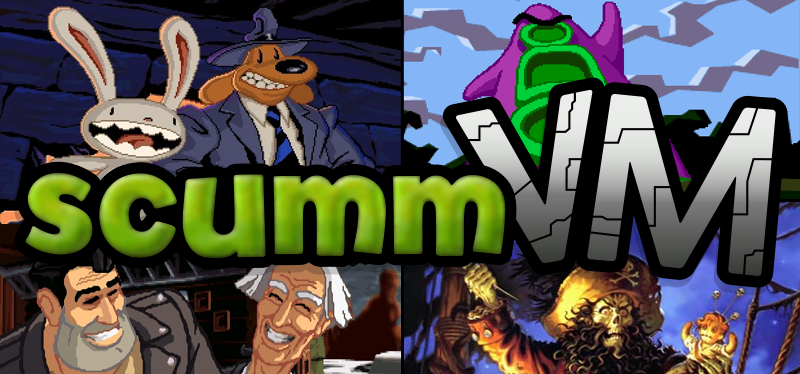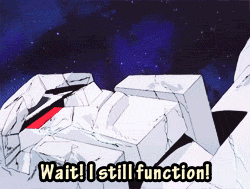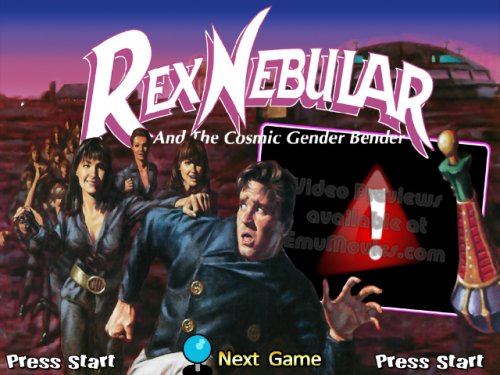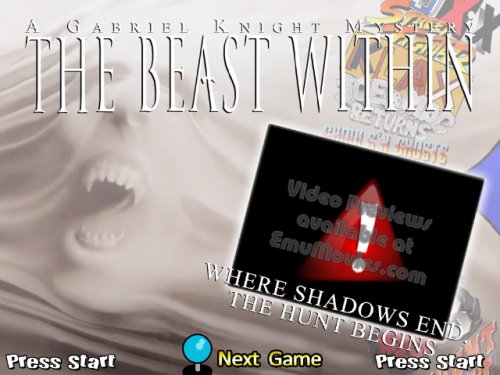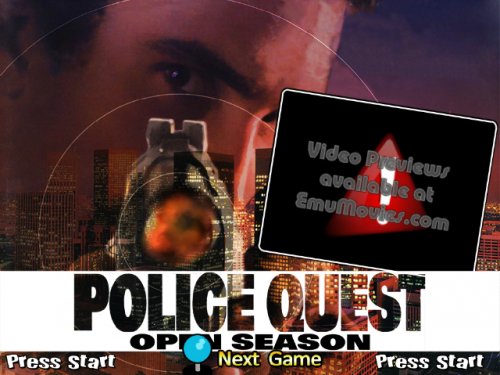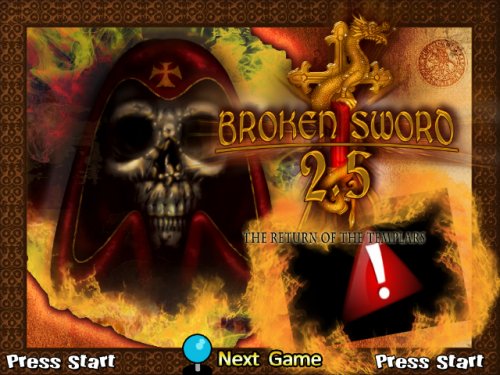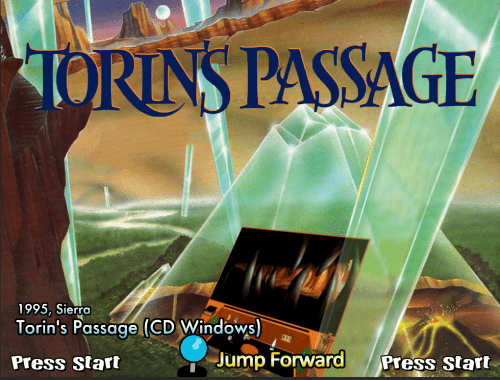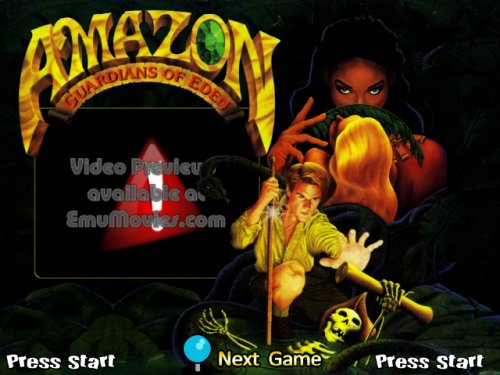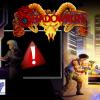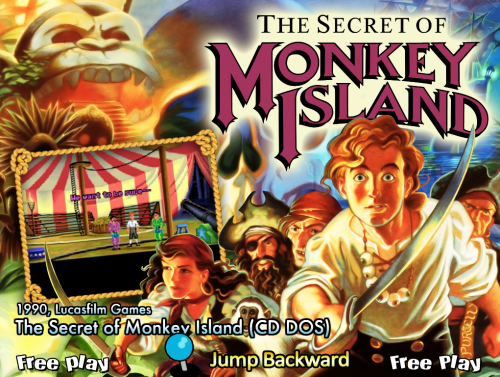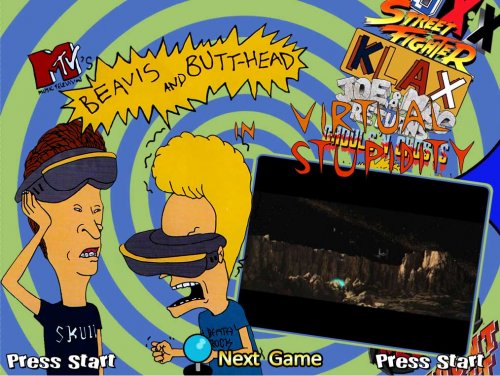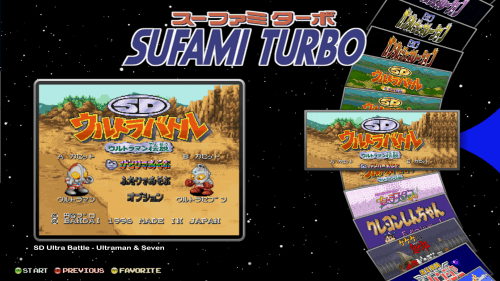Greetings I hereby release the complimentary Wheel Sound pack for Microsoft MS-DOS
the pack features sounds from games like:
- Space quest
- Commander Keen
- Wolfenstein 3d
- Doom
- Star Wars Dark forces
- Blood
- Warcraft 2
- Barbarian
- Prince of Persia
and many more
Greetings,
I Decided to upload the sound pack for Hyperspin's Ultimate DooM Single player Collection:
it contains sounds to be played when ever you skip to the next wheel.
enjoy
Forum : link to the forum thread with more goodies
Edit 17-11-2016
As of Today , ZeroJay's Ultimate doom single player collection will be known as Hyperspin's Ultimate Doom single player collection. please give ZeroJay a Beer for his hardwork!
Database : http://www.hyperspin-fe.com/files/file/12605-hyperspin-ultimate-doom-single-player-collection-database/
Letter pack : http://www.hyperspin-fe.com/files/file/12604-hyperspins-ultimate-doom-single-player-collection-letter-pack/
Sound pack : http://www.hyperspin-fe.com/files/file/12603-hyperspins-ultimate-doom-single-player-collection-sound-pack/
Wheel pack : http://www.hyperspin-fe.com/files/file/12602-hyperspin-s-ultimate-doom-single-player-collection-wheel-pack/
Rex Nebular and the Cosmic Gender Bender is a point-and-click graphic adventure game developed and published by MicroProse in November of 1992. The game is the first graphical adventure game developed by MicroProse. It was developed using the MicroProse Adventure Development system, and made use of 256-colour graphics.[1]
Tommo purchased the rights to this game and digitally publishes it through its Retroism brand in 2015.[2]
The Beast Within: A Gabriel Knight Mystery is an interactive movie point-and-click adventure game released by Sierra On-Line in 1995. Unlike its predecessor Gabriel Knight: Sins of the Fathers, released in 1993, The Beast Within was produced entirely in full motion video. The technology was popular at the time of the game's production with the recently introduced storage capabilities of CD-ROMs, but was expensive to produce. Its sequel, Gabriel Knight 3: Blood of the Sacred, Blood of the Damned used a rendered 3D engine.
In 1996, Computer Gaming World magazine named it their game of the year.[3]
Police Quest: Open Season is the fourth installment of Sierra On-Line's popular Police Quest series. Released in 1993, it was created by retired Police Chief Daryl F. Gates, who was the Chief of the Los Angeles Police Department (LAPD) from 1978 to 1992. He replaced ex-California Highway Patrol officer Jim Walls as the designer of the franchise.
The game is listed as Police Quest 4 (PQ4) in the manual. It is also shown in the file names and the credits, and when exiting the game in DOS, "Thank you for playing Police Quest IV: Open Season". The number does not appear on the title screen.
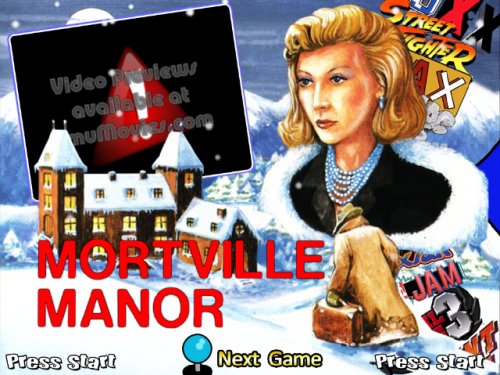
Mortville Manor (French: Le Manoir de Mortevielle) is a point-and-click adventure game developed and published by Lankhor in 1987 on Atari ST. There were several adaptations, amongst other Amstrad CPC, Amiga, IBM PC compatibles. The game was released in French, English and German. Its speech synthesis was a first at the time.
You are Jérôme Lange, a famous private investigator, involved in the strange events of the Mortville Manor. The game can be solved extremely quickly if you are given the solution. After a French computer magazine published a walkthrough, allowing its readers to solve the game without even having understood the plot, an altered version was published and replaced the original. This new version was completely identical except that at a specific point in the adventure, the player had to correctly answer a series of questions about the game's plot to be allowed to continue further.
The game was written by Bernard Grelaud and Bruno Gourier, with illustrations by Dominique Sablons with Maria-Dolores. Music and voices were provided by Beatrice Langlois and Jean-Luc Langlois. "Le Manoir de Morteveille" was subsequently translated into English (Mick Andon) and German. A version for PC was released in 1988, adapted by Clement Roques.
Mortville Manor was followed by its sequel Maupiti Island, taking place on a tropical island.
Broken Sword 2.5 The Return of the Templars is an unofficial part of the Broken Sword series. It is a game created by fans to explain what happens during the time between Broken Sword II: The Smoking Mirror and Broken Sword: The Sleeping Dragon. This fan game was originally released in German but an English voice pack was released during 2010 making the game available in both English and German. It is a short game that stays relatively true to the story and feeling of the series. As can be expected by a game created by hardcore fans of the game. The game is a freeware windows game and can be downloaded by anyone for free. The game was developed and released by german company MindFactory. The game took an entire eight years to develop and the development started in the year 2000. The final product was released on 28 September 2008. The game was an response to the gap in the story that fans see between the second and third game.
Torin's Passage is a point-and-click adventure game developed and published by Sierra On-Line in 1995. The game was designed by Al Lowe but holds the distinction of being a family friendly game by Lowe, author of the adult-oriented Leisure Suit Larry series of games.
Amazon: Guardians of Eden is a point-and-click adventure video game for MS-DOS from Access Software. It is one of the first games to feature super VGA graphics, digitized voice-overs, and an online (in game) hint system.[1] Amazon is a movie adventure game about a 1957 expedition into the heart of the Amazon basin: "a desperate, crazed message sends [the player] on a perilous search through a land where legends come to life, danger hides behind every corner, and incredible treasures wait to be discovered."
Game Theme of Shadowrun for sega genesis with animated background
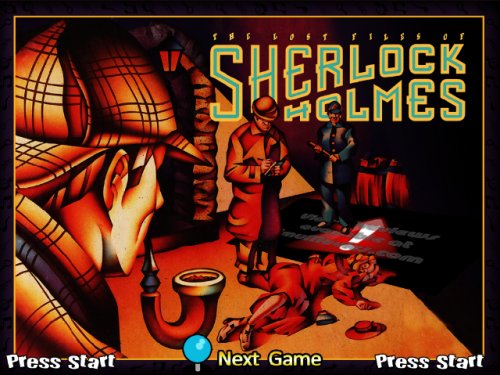
The Lost Files of Sherlock Holmes is an adventure game series developed by Mythos Software and published by the American computer game company Electronic Arts for DOS in the 1990s. The series contains The Case of the Serrated Scalpel (1992), and The Case of the Rose Tattoo (1996).
The Case of the Serrated Scalpel
The player, as Sherlock Holmes, is engaged by Scotland Yard to help with the murder investigation of a young actress. While the manner of her death suggests this is another strike by Jack the Ripper, Holmes believes someone else had committed the crime. The investigation takes Holmes and Watson to many parts of late 19th Century London, including a perfume shop, the zoological gardens, the morgue, a pub, several dwellings, Surrey Commercial Dock, Savoy Street Pier, St Pancras Station, and of course 221B Baker Street.
The graphics are VGA, with MIDI music and a few scenes with digitalized speech (in the intro and end sequence, and the cutscene at St Pancras Station. In the other scenes there are sound effects, but no speech). The player interacts with the characters through a command menu with verb icons that is intuitive for anyone who had played other adventure games of the period. In 1994 the game was released for 3DO as full talkie and the portraits of the talkers were replaced by clips with video actors.
ScummVM - ThatPurpleStuff's Themes
Greetings, I tend to post a excerpt from the corresponding Wikipedia Article, but not today.
As I am currently working on the completing the missing themes for the ScummVM system, I noticed that the themes that ThatPurpleStuff made back in 2013/2014 were not available here in the downloads section.
So without boring you any further with why and how I am hereby releasing his work as two archives, one containing the themes and the other containing the wheels.
221 themes and wheels.
Hopefully this pack will find you well and out of appreciation go over to @thatpurplestuff's Profile and write something on his wall as a thank you.
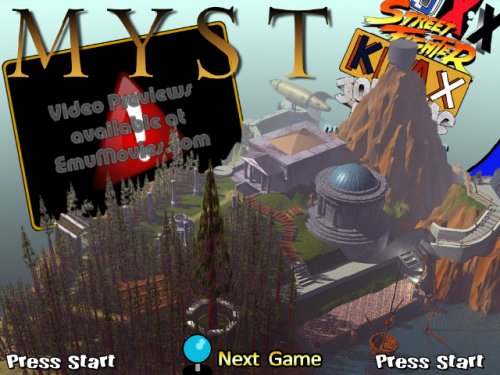
Myst is a graphic adventure puzzle video game designed by the brothers Robyn and Rand Miller. It was developed by Cyan, Inc., published by Brøderbund, and initially released on the Macintosh platform in 1993. Remakes and ports of the game have been released for platforms including the Sega Saturn, PlayStation, 3DO, Microsoft Windows, Atari Jaguar CD, CD-i, AmigaOS, PlayStation Portable, Nintendo DS, iOS, OS X, and Android.
The game puts the player in the role of the Stranger, who uses a special book to travel to the island of Myst. There, the player solves puzzles and travels to other worlds known as "Ages". Clues found in each of these Ages help to reveal the back-story of the game's characters. The game has several endings, depending on the course of action the player takes.
After producing several interactive games aimed at children, the Miller brothers decided to create an adult-targeted game with a non-linear story, believable characters, and an ethical dilemma. Initially turned down by Activision, Cyan was later approached by Sunsoft, who helped fund Myst. The game took two years to develop and was Cyan's largest project.
Upon release, Myst was a surprise hit, with critics lauding the ability of the game to immerse players in the fictional world. The game was the best-selling PC game until The Sims exceeded its sales in 2002. Myst helped drive adoption of the then-nascent CD-ROM format. Myst's success spawned four direct video game sequels as well as several spin-off games and novels.
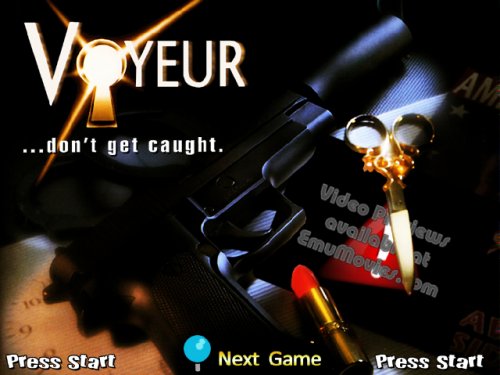
Voyeur is an interactive movie video game released in 1993 for the Philips CD-i. DOS and Macintosh computer ports were later released. A major selling point for the game was the "mature" content of the full motion video sequences, with a number of simulated sex scenes.
The player takes on the role of a private investigator hired by a member of the wealthy Hawke family in order to gain enough evidence to bring down the corrupt Reed Hawke (played by Robert Culp), CEO of Hawke Industries. Hawke has gathered his family together for the weekend to prepare for his announcement that he will be running for President of the United States. The player controls a video camera located in a building opposite to spy on the Hawke family home in an effort to gather enough evidence to destroy Reed Hawke's career. The player character's client is randomly selected each time a new game is started, and the storyline also changes according to the player's actions.
The game uses the surveillance concept pioneered by the Digital Pictures game Night Trap, but without the "trap-em-up" elements. A sequel was released for DOS and Mac OS, and a finished beta version of the sequel for Philips CD-I has been discovered and distributed on various abandonware sites.
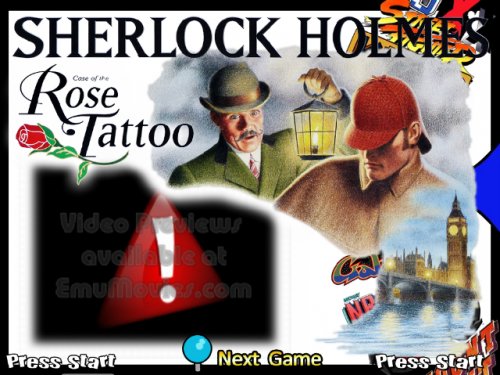
The Lost Files of Sherlock Holmes is an adventure game series developed by Mythos Software and published by the American computer game company Electronic Arts for DOS in the 1990s. The series contains The Case of the Serrated Scalpel (1992), and The Case of the Rose Tattoo (1996).
The Case of the Rose Tattoo[edit]
Holmes' brother Mycroft is caught in an explosion when his club, the Diogenes, is blown up. The player, first as Doctor Watson and then as Sherlock Holmes, investigates the explosion and discovers that it was not a gas leak but a bomb which was the cause. This leads them to investigate a case of espionage and the strange death of an unidentified man. In this game, establishing the identity of the victim is as important as finding out who killed him. The intricate plot leads the player to a great number of locations over town and involves several subplots.
The game is longer than its predecessor and features a much higher degree of historical accuracy and detail. The graphics are near-photo quality and the atmospheric sounds more are realistic, while the background music, which communicated the mood of the scenes in the first game, is applied less in the Rose Tattoo. Unlike the previous game, digitized speech is employed throughout the game and adds characterization to the NPCs.
The characters in the game were made by filming real actors in costume, against a bluescreen. While the characters are thus more lifelike, Rose Tattoo did not display large, high-quality faces shown during dialogues in the first game. A similar use of in-game video can also be found in e.g. Jones in the Fast Lane and Under a Killing Moon and in retrospect appears as a transient trend permitted by the available hardware. The CD-ROM greatly increased the data storage space available to a computer game. Most games of this period filled the empty space by enhancing the game with digitized speech and cut-scene videos. Later, advances in CPU and graphic card hardware allowed high-resolution characters to be rendered in 3D.
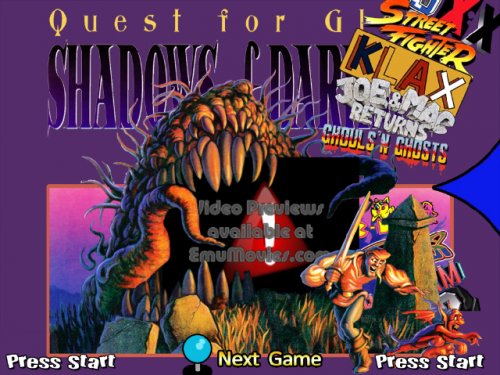
Quest for Glory is a series of hybrid adventure/role-playing video games, which were designed by Corey and Lori Ann Cole.[1][2][3][4][5] The series was created in the Sierra Creative Interpreter, a toolset developed at Sierra specifically to assist with adventure game development.[6][7] The series combines humor, puzzle elements, themes and characters borrowed from various legends, puns, and memorable characters, creating a 5-part series in the Sierra stable.
The series was originally titled Hero's Quest. However, Sierra failed to trademark the name. The Milton Bradley Company successfully trademarked an electronic version of their unrelated joint Games Workshop board game, HeroQuest, which forced Sierra to change the series' title to Quest for Glory.[8][9][10] This decision meant that all future games in the series (as well as newer releases of Hero's Quest I) used the new name.
Quest for Glory: Shadows of Darkness[edit]
Main article: Quest for Glory: Shadows of Darkness
Drawn without warning from his victory in Fricana, the Hero arrives without equipment or explanation in the middle of the hazardous Dark One Caves in the distant land of Mordavia. While struggling to survive in this land plagued with undead, the Hero must prevent a dark power from summoning eternal darkness into the world.
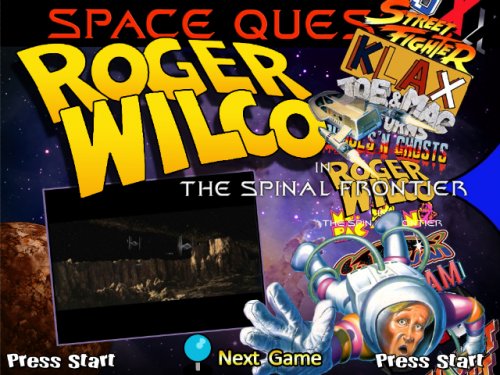
The game begins with Roger Wilco being court martialed for various, humorous reasons (all of which Roger, being the idiot that he is, cannot defend properly). He is demoted back to his position as second class janitor aboard the SCS DeepShip 86 (a parody of the Deep Space 9). Among the reasons for Roger being simply demoted and not expelled from StarCon is the "safe return of the SCS Eureka". This is a continuity error in that the Eureka was in fact destroyed in Space Quest V.
Later, on the DeepShip, Commander Kielbasa (named after the kielbasa sausage and a parody of the Kilrathi from the Wing Commander series of video games) announces that, as reward for their excellence in "A Glitch In Time Saves Gamma Nine" (a parody of "a stitch in time saves nine"), they are to be given shore leave on the planet Polysorbate LX ("LX" pronounced "sixty", after the preservative). Meanwhile, an extremely old and wrinkled woman named Sharpei (after the dog breed of the same name, also noted for its wrinkles, and voiced by Lucille Bliss) is revealed to be plotting Roger's demise. It is later revealed that she is the subject of "Project Immortality", which was supposed to prolong life indefinitely.
Roger's adventures throughout the game have him dealing with a T-1000 like "endodroid" (a reference mostly to the replicants from Blade Runner, including an "endodroid runner" giving Roger the assignment and speaking with a New York accent), entering cyberspace (mostly a desert canyon like area, an "office" resembling Windows 3.1, and a seemingly endless room of file cabinets known as the "file manager"), and venturing into Stellar Santiago's digestive system (for which humor is added through Gary Owens' narrations providing scientific detail of everything within each area, as if from a textbook).
Roger and Stellar develop a relationship that almost attracts Roger to the point of enamoration for her. This was designed as a way to potentially create another love interest for Roger. A running gag in the game is the inclusion of a rotting fish in Roger's inventory which he cannot seem to get rid of. It is revealed in an anti-climatic end that the fish is the only way to destroy Sharpei, who by the end of the game has become a virus infecting Stellar Santiago.
The game ends on a cliffhanger, with Stellar saying that Roger "is going to like his next mission". Despite this, Space Quest 7 never came to fruition, and the cliffhanger was never resolved.
Special Thanks to @wesfranks for providing the background. he's a great fart knocker~!
Beavis and Butt-Head in Virtual Stupidity is a point and click adventure computer game based on the American animated television series created by Mike Judge, Beavis and Butt-Head, that was developed by ICOM Simulations and published by Viacom New Media. It was released on August 31, 1995.[1]
It featured vocals from the series' cast of voice actors, including Mike Judge.[2] Besides the main game, four mini-games are featured, called Hock-A-Loogie, Court Chaos, Bug Justice, and Air Guitar.
The main game plots the two main characters, Beavis and Butt-head, trying to get into Todd's gang. Over the course of the game, they have to complete tasks[3] and explore areas in the fictional town of Highland, Texas.
It was originally released on the PC. A CD-i port of Virtual Stupidity was planned but was cancelled due to falling sales of the console. A PlayStation port was made, but was only released in Japan.
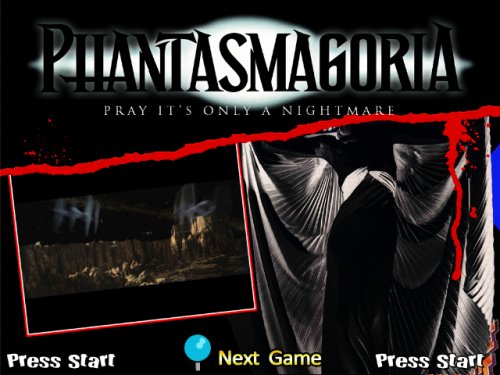
Phantasmagoria is a point-and-click adventure game designed by Roberta Williams for MS-DOS and Microsoft Windows. Released by Sierra On-Line on August 24, 1995, it tells the story of Adrienne Delaney (Victoria Morsell), a writer who moves into a remote mansion and finds herself terrorized by supernatural forces. Made at the peak of popularity for interactive movie games, Phantasmagoria features live-action actors and footage, both during cinematic scenes and within the three-dimensional rendered environments of the game itself. Upon release, it was noted for its graphic gore, violence, and sexual content.
Williams had long planned to design a horror game, but waited eight years for software technology to improve before doing so. More than 200 people were involved in the making of Phantasmagoria, which was based on Williams' 550-page script, about four times the length of an average Hollywood screenplay. It took more than two years to develop and four months to film. Originally budgeted for US$800,000, the game ultimately cost $4.5 million to develop, and it was filmed in a $1.5 million studio Sierra built specifically for the game.
Directed by Peter Maris, the game features a cast of 25 actors, all performing in front of a blue screen. While most games at the time featured 80 to 100 backgrounds, Phantasmagoria includes more than 1,000. A professional Hollywood special effects house worked on the game, and the musical score includes a neo-Gregorian chant performed by a 135-voice choir. Sierra stressed it was intended for adult audiences. The company willingly submitted it to a ratings system, and included a password-protected censoring option within the game to tone down the graphic content.
Released on seven discs after multiple delays, Phantasmagoria was a financial success, grossing $12 million in its opening weekend and becoming one of the best-selling games of 1995. Sierra strongly promoted the game. It received mixed to positive reviews, earning praise for its graphics and suspenseful tone, but was criticized for its slow pacing and easy puzzles. The game drew controversy, particularly due to a rape scene. CompUSA and other retailers declined to carry it, religious organizations and politicians condemned it, and it was banned altogether in Australia. A sequel, Phantasmagoria: A Puzzle of Flesh, was released in 1996, although Williams was not involved.
Blake Stone: Aliens of Gold is a first-person shooter computer game created by JAM Productions and published by Apogee Software. It uses the Wolfenstein 3D game engine to render graphics in first person, while adding many features, such as floor and ceiling textures.
The shareware version of the game was released December 3, 1993. The registered version of Blake Stone shipped with a comic book, called "Blake Stone Adventure". id Software released Doom one week after Apogee released Blake Stone.[1] Doom quickly eclipsed Blake Stone, which sold poorly after initial success.[1] In 1994, a sequel called Blake Stone: Planet Strike was released, which continues where Aliens of Gold leaves off.
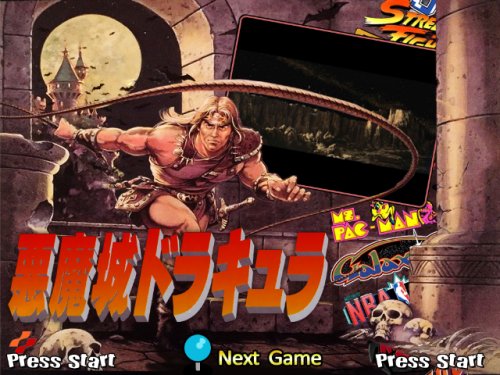
Castlevania Chronicles, released in Japan as Castlevania Chronicle: Akumajō Dracula (悪魔城年代記キャッスルヴァニアクロニクル 悪魔城ドラキュラ Kyassuruvania Kuronikuru Akumajō Dorakyura?), is a platform video game developed by Konami for the PlayStation.[1] It is a port of a game originally released for the Sharp X68000 home computer in 1993 as simply Akumajō Dracula (悪魔城ドラキュラ Akumajō Dorakyura?, "Devil's Castle Dracula").[2] This Castlevania Chronicles port adds a number of features, including an Arranged Mode for new players.[3][4] Much like Super Castlevania IV, Castlevania Chronicles is positioned as a remake of the original Castlevania for the Nintendo Entertainment System, where the vampire hunter Simon Belmont must defeat Dracula and save Transylvania.
It was made available for download via the PlayStation Network as a PSone Classic on December 18, 2008.
Comparison of Castlevania Chonicles and akumajou dracula for x68000
written up by Ray hardgrit
Akumajō Dracula (X68000)
Another Castlevania game with the Japanese title Akumajou Dracula, retelling the story of Simon Belmont's epic struggle through Castlevania 1. So that's... five of them now, right?
For years this was only available in Japan for the Sharp X68000 computer, but it finally got a western release in 2001 on the PlayStation, under the name Castlevania Chronicles.
Team Evil conspire to resurrect their dark lord, Dracula. And apparently succeed.
Fortunately Simon Belmont is onto their sinister scheme, and heads inside Dracula's castle to put him right back into his coffin. Again.
Though this is definitely the most dramatic of the 'Simon stands in front of a castle' prologues. Instead of the castle being a sinister silhouette in the distance, this time it towers over our hero.
Simon doesn't care though, he just whips his Vampire Killer whip and strolls instead.
Count Dracula's front garden seems more colourful than last time I was here. But otherwise this seems just how it was in Castlevania 1.
It's even playing Vampire Killer, the stage one music from the NES game.
Castlevania (NES)
There's the nasty looking trees, the statue, the fence along the back and the fires I smash open to get heart ammo for my sub-weapons. Even the HUD is the same.
Hey, it's these guys again, racing to die by a single crack of my whip.
Castlevania (NES)
You know, of all the retellings of Castlevania I've played so far, this is definitely the closest to the original.
Annoyingly Simon is also glued back to stairs again. In Super Castlevania IV I could hop on to stairs, and drop down from them, but in this I'm locked onto them until I reach the top or bottom. And he walks up them painfully slowly.
He doesn't have Super Castlevania IV's awesome multi-directional whip attack either. Plus he can't walk while crouching. He CAN move in the air while jumping though, which seems a weird thing to change if you're keeping everything else the same, but I'm definitely not complaining.
Castlevania Chronicles (PSX)
The PlayStation version of the game is pretty much identical as far as I can tell. But it does come with 'Arrange Mode', which changes the graphics a bit, adds some effects like glowing candles, and swaps out the music with a new soundtrack.
Weirdly it also changes Simon's hair pink, and to be honest I don't think it suits him.
The Evolution of Simon
I think that's all the Simon Belmonts now, including blue haired Giant Simon from the first arcade game. I think this game might actually have the most authentic looking Simon out of all of them, assuming the box art to the first game is what he's supposed to look like.
Whoa, I don't remember seeing that in the NES version.
Castlevania (NES)
One good thing about this being a remake, is that I already know where some of the health pickups will be hidden.
Well, the wall broke... but there's nothing in here. That's pretty cruel of them I reckon.
OH SHIT WHAT THE FUCK!
I've opened the floodgates and now infinite hunchbacks are pouring in.
SOON.
Well the good news is that I've found where Dracula hid his lunch. The bad news is that if I stop whipping and go to grab it I'll be swarmed by enemies.
Aw fuck it, I'm grabbing the meal and making a run for the stairs.
Oh, it's this guy again. Fortunately I remembered to bring along plenty of axes.
Castlevania (NES)
If I remember right, the strategy for this guy is to grab the 'II' power up from this brick, then use it to throw two axes at a time up at him.
Oh crap, the first hit turned him into a homing swarm of bats. It seems that I have to wait for the swarm to dive at me, then run out of the way.
The new improved bat boss wasn't so bad.
Huh, didn't the map used to go up at this point?
Castlevania (NES)
It seems like I'm going through an entirely different route from now on. I guess they got bored with remaking Castlevania.
Castlevania Chronicles (PSX)
The Castlevania Chronicles Arrange Mode version of of the map has been totally redrawn for whatever reason. Personally I through it looked fine the first time, but this is good too.
I have no idea why they thought that making me slowly hack through walls of slime would be a good idea. Hitting things is often fun, but not when I have to slowly chip away at series of walls for no reason.
Hey, the water didn't instantly kill him, that's always g.... oh SHIT there's an enemy behind me! These games have been pretty good so far with making enemies stand out, but these guys always look like they're in the background to me.
It doesn't help that they often are in the background, flying past.
Hey these two areas kind of look the same... nah I'm stretching. Except for the raft and the water this is pretty much a completely different area to anything in the NES game. Though ducking is still recommended.
SOON.
Well... fuck. This raft used to be much bigger than this, but water is flooding this cavern and as the raft goes up, it hits pieces of the background and splits apart. And tilts. And these mermen keep jumping up and spitting fireballs at me, which will be an instant kill at this point seeing as I've got nowhere to land but water if I'm hit.
And if I get killed I'll be put back all the way at bottom again.
Oh shit oh shit, what just happened? I think my raft got stuck on something so I have to jump up and reach the next one.
This wouldn't even be a problem if Simon would just learn to swim.
Oh shit, now I have to fight a boss? This game is an asshole!
I bet if this guy kills me I'm going to be put back all the way down at the bottom again, though I'm not keen to test that theory. Because I got killed earlier I'm back to using the crappy non-upgraded starting whip, so this may take a while.
Stage 7! Though it feels more like I should be up to stage 15 by now. These bug things are really starting to annoy be because of how long they take to kill. Plus every time I wander too close to a tree I get attacked by one of those tree monsters I haven't seen since Haunted Castle.
But damn those are some nice looking trees. Sorry Super Castlevania IV, you look pretty good but right now this game looks better.
What the FUCK? The birds have teamed up with the hunchbacks!
Castlevania (NES)
To be fair this bit actually is in the original Castlevania game. Actually there's nothing fair about this! Hunchbacks and birds teaming up... they're bad enough separately.
I ran away from the hunchbacks, but I didn't get far. I got swarmed by evil droplets of water. Not really much of a heroic death for poor Simon. I'll continue and try to give him a better one.
That's pretty cool, how the arrows stick in him. Though they're big enough to be javelins really.
I made it out of that second with pretty much zero health, I did terrible. But I did manage to grab this strange plant sub-weapon. Which actually turned out to be a healing item. This thing uses up hearts to give me back health. Which means I actually have a chance of getting somewhere now.
I'm pretty sure this thing wasn't in the original Castlevania. In fact I don't think any of this was, we're back in uncharted territory. Like all the other retellings of Simon's fight with Dracula, this is pretty much it's own game.
Stage 9 is a slippery slidey ice stage. Great.
I was stuck for a while trying to figure out how to get through this wall, but it seems that the game got bored waiting for me to try attacking the floor instead, and smashed it for me.
Hey, I recognise that guy!
Oh shit shit shit, no! I just collected a bloody dagger sub-weapon by accident. Now I've lost my ultra rare healing plant.
LATER.
It turns out it probably didn't matter what I had equipped, because this guy seems to be knocking the power ups right out of me.
No, don't bring the monster out! Come back and give me something I can hit you son of a bitch. I don't have time to fuck around here.
I really don't! I have 12 seconds left to finish this fight, and it's all being wasted because this guy keeps sending this creature out to fight for him.
The time counter reaches 000 and Simon keels over. I could have won that battle too.
BACK AT THE START OF THE STAGE.
Oh crap! I didn't realise this pillar moved up so fast. I was lucky first time around and jumped off immediately.
This time though it's an instant kill. Back to the start.
It's kinda hard to jump over a pit on a slidey ice stage when the floor slopes towards it. I guess I must have been lucky first time I managed this too.
And then Simon Belmont joins the other falling heroes decorating the level because there's no way I'm going to continue from all the way back at stage 7... with those bloody hunchbacks and birds.
The game has infinite continues and uses saves instead of passwords, so it's probably on the right side of winnable. But it feels like a step backwards after Super Castlevania IV... backwards into an insta-kill pit. The gameplay is solid, and it's not as ridiculously challenging as Haunted Castle (yet), but really don't want to go back and try all that again. So it doesn't get a gold star.
Original post by @Jumpman311
Files were parked on FTP. I thought I post them here..
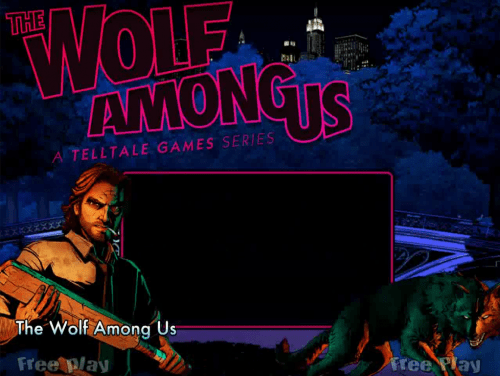
Theme by @Bungles
The Wolf Among Us is an episodic interactive fantasy mystery graphic adventure video game based on Bill Willingham's Fables comic book series.[12] It is developed by Telltale Games. It is canon with the comic book universe and is set as a prequel to the comic book.[13] The game consists of five episodes,[14] with the first episode being released for Microsoft Windows and Xbox 360 worldwide on October 11, 2013,[5] for OS X worldwide on October 14, 2013,[4] for PlayStation 3 on October 15, 2013, in North America[5] and on October 16, 2013, in Europe and Australia,[6] for iOS worldwide on December 4, 2013,[7] and PlayStation Vita before the end of 2014.[15] Retail versions for the PlayStation 3, PlayStation 4, PlayStation Vita, Xbox 360, and Xbox One consoles were released in November 2014.[16]
<game name="The Wolf Among Us" index="true" image="w">
<description>The Wolf Among Us</description>
<cloneof></cloneof>
<crc></crc>
<manufacturer></manufacturer>
<year></year>
<genre></genre>
<rating>HSRS - M15 (Mature Adults Only)</rating>
<enabled>Yes</enabled>
</game>
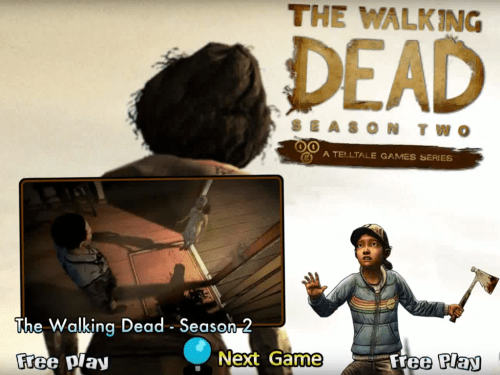
Theme by @Bungles
The Walking Dead: Season Two is an episodic interactive drama graphic adventure game based on Robert Kirkman's The Walking Dead comic book series developed by Telltale Games. It is the sequel to The Walking Dead, with the episodes released between December 2013 and August 2014, and a retail collector's disc edition planned at the conclusion of the season.[14][15][16] The game employs the same narrative structure as the first season, where player choice in one episode will have a permanent impact on future story elements. The player choices recorded in save files from the first season and the additional episode 400 Days carry over into the second season.[17]Clementine, who was the player's companion during the first season, is the player-character in Season Two.[18]
A third season, a full sequel to Season Two, titled The Walking Dead: A New Frontier was released on December
<game name="The Walking Dead - Season 2" index="true" image="w">
<description>The Walking Dead - Season 2</description>
<cloneof></cloneof>
<crc></crc>
<manufacturer></manufacturer>
<year></year>
<genre></genre>
<rating>HSRS - M15 (Mature Adults Only)</rating>
<enabled>Yes</enabled>
</game>
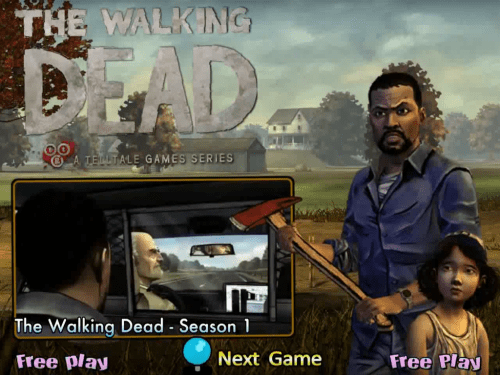
Theme by @Bungles
The Walking Dead (also known as The Walking Dead: The Game[5] and The Walking Dead: Season One[6]) is an episodic interactive drama graphic adventure survival horror video game developed and published by Telltale Games. Based on Robert Kirkman's The Walking Dead comic book series, the game consists of five episodes, released between April and November 2012. It is available for Android, iOS, Kindle Fire HDX, Microsoft Windows, Mac OS X, PlayStation 3, PlayStation Vita, Xbox 360, PlayStation 4 and Xbox One. The game is the first of The Walking Dead video game series published by Telltale.
The game takes place in the same fictional world as the comic, with events occurring shortly after the onset of the zombie apocalypse in Georgia. However, most of the characters are original to the game, which centers on university professor and convicted criminal Lee Everett, who helps to rescue and subsequently care for a young girl named Clementine. Kirkman provided oversight for the game's story to ensure it corresponded to the tone of the comic, but allowed Telltale to handle the bulk of the developmental work and story specifics. Some characters from the original comic book series also make in-game appearances.
Unlike many graphic adventure games, The Walking Dead does not emphasize puzzle solving, but instead focuses on story and character development. The story is affected by both the dialogue choices of the player and their actions during quick time events, which can often lead to, for example, certain characters being killed, or an adverse change in the disposition of a certain character or characters towards Lee. The choices made by the player carry over from episode to episode. Choices were tracked by Telltale, and used to influence their writing in later episodes.
The Walking Dead has been critically acclaimed, with reviewers praising the harsh emotional tone of the story and the empathetic connection established between Lee and Clementine. It won year-end accolades, including Game of the Year awards from several gaming publications. More than one million unique players have purchased at least one episode from the series, with over 8.5 million individual units sold by the end of 2012, and its success has been seen as constituting a revitalization of the weakened adventure game genre. In July 2013, Telltale released an additional downloadable episode, 400 Days, to extend the first season and bridge the gap towards the second season. At the July 2014 San Diego Comic-Con Telltale Games and Skybound have announced that a third season is being developed, and that the first two seasons to date have sold more than 28 million episodes.[7] The third season premiered on December 20, 2016.[8]
<game name="The Walking Dead - Season 1" index="true" image="w">
<description>The Walking Dead - Season 1</description>
<cloneof></cloneof>
<crc></crc>
<manufacturer></manufacturer>
<year></year>
<genre></genre>
<rating>HSRS - M15 (Mature Adults Only)</rating>
<enabled>Yes</enabled>
</game>

